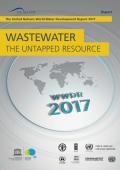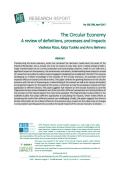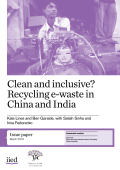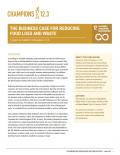
Most human activities that use water produce wastewater. As the overall demand for water grows, the quantity of wastewater produced and its overall pollution load are continuously increasing worldwide. Over 80% of the world’s wastewater – and over 95% in some least developed countries – is released to the environment without treatment. Once discharged into water bodies, wastewater is either diluted, transported downstream or infiltrates into aquifers, where it can affect the quality (and therefore the availability) of freshwater supplies. The ultimate destination of wastewater discharged into rivers and lakes is often the ocean with negative consequences for the marine environment.

Transforming the linear economy, which has remained the dominant model since the onset of the Industrial Revolution, into a circular one is by no means an easy task. Such a radical change entails a major transformation of our current production and consumption patterns, which in turn will have a significant impact on the economy, the environment and society. Understanding these impacts is crucial for researchers as well as for policy-makers engaged in designing future policies in the field. This requires developing an in-depth knowledge of the concept of the circular economy, its processes and their expected effects on sectors and value chains. This paper reviews the growing literature on the circular economy with the aim of improving our understanding of the concept as well as its various dimensions and expected impacts. On the basis of this review, it attempts to map the processes involved and their application in different sectors. The paper suggests that research on the circular economy is currently fragmented across various disciplines and there are often different perspectives and interpretations of the concept and the related aspects that need to be assessed.

E-waste – electrical and electronic waste – is one of today’s fastest growing waste streams. By managing it well, we can recover valuable raw materials and reusable parts, with significant associated emissions savings. But much of its potential is lost when incorrectlly processed by informal and unregulated enterprises. This can damage both people’s health and the environment and intensify the vulnerability of workers.
Informal markets are where most of the world’s poor produce, consume and trade goods. Using case studies from China and India – both with huge informal e-waste sectors – this paper explores how to build inclusive, greener economies that retain the benefits of informal markets, while addressing how and why people are excluded from formal activities. Both countries are stepping up efforts to regulate but are failing to take into account the importance of engaging with the informal e-waste sector. How can drives to clean up harmful practices take their experience and expertise into account? And how can we develop effective policies to tackle pollution while supporting the health, livelihoods and economic activities of the poor and vulnerable?

According to available estimates, approximately one-third of all food produced in the world intended for human consumption is lost or wasted. This level of inefficiency in the global food system has significant economic, social, and environmental impacts. It amounts to economic losses of $940 billion per year. It means that more than a billion tonnes of food never gets consumed each year, while one in nine people remains undernourished. In addition, food loss and waste are responsible for an estimated 8 percent of annual greenhouse gas emissions; if it were a country, food loss and waste would be the third-largest emitter after China and the United States.
This report updates the 2001 Guidance Manual for Governments on Extended Producer Responsibility (EPR), which provided a broad overview of the key issues, general considerations, and the potential benefits and costs associated with producer responsibility for managing the waste generated by their products put on the market. Since then, EPR policies to help improve recycling and reduce landfilling have been widely adopted in most OECD countries; product coverage has been expanded in key sectors such as packaging, electronics, batteries and vehicles; and EPR schemes are spreading in emerging economies in Asia, Africa and South America, making it relevant to address the differing policy contexts in developing countries.
In light of all of the changes in the broader global context, this updated review of the guidelines looks at some of the new design and implementation challenges and opportunities of EPR policies, takes into account recent efforts undertaken by governments to better assess the cost and environmental effectiveness of EPR and its overall impact on the market, and addresses some of the specific issues in emerging market economies.
